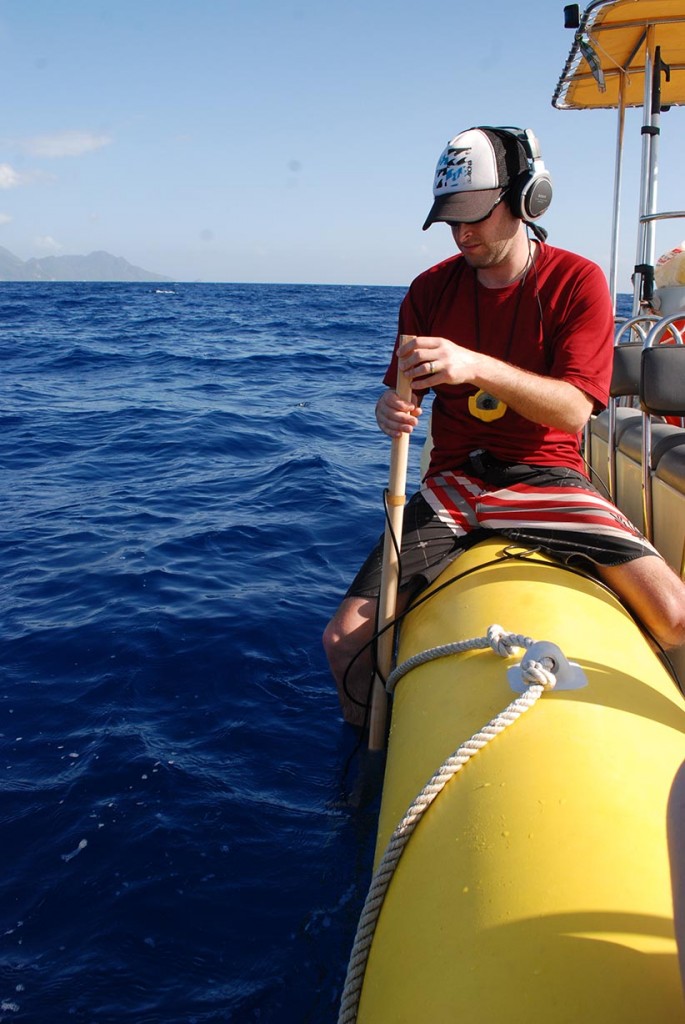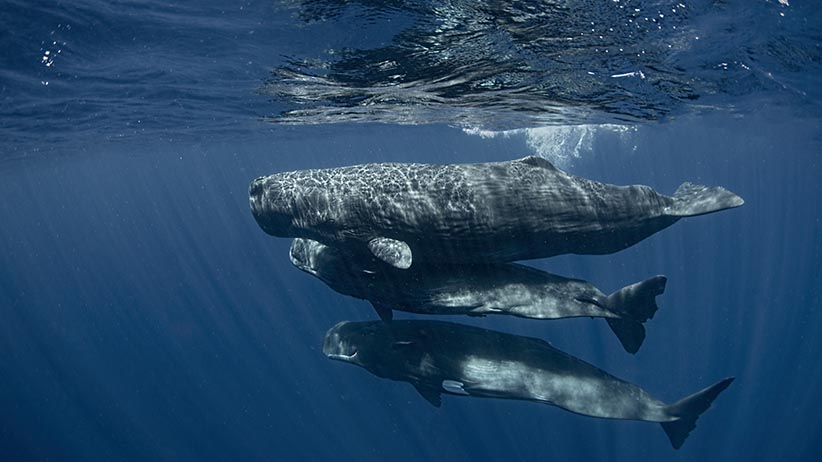‘Have we met?’: Sperm whales can talk, and even have dialects
From 2016: Research reveals an unprecedented view into the social lives of these ocean mammals, who can use ‘vocal clans’ to distinguish themselves
The three calves of Unit R swim together at the surface. ‘Riot’, in the middle is still too young to dive deeply with her mother and so must be escorted at the surface to protect her from predators. Groups of calves are often left alone at the surface while the females in the unit hunt for squid at depth. Otherwise, calves have adult babysitters, who are often the mother’s closest relatives. Sperm whale society is matrilineal; grandmothers, mothers and calves living together for life and communal care for calves is the key to their social groups. (Amanda Cotton)
Share

The deep ocean is the least-understood environment on our planet, and the sperm whale is one of its strangest inhabitants. It has the biggest brain of any species, and a massive head filled with a waxy substance called spermaceti, once prized by whalers. It can dive more than 2,000 m deep to feast on giant squid, hunting in the dark with echolocation, and stay under for an hour. Sperm whales are the stuff of legend, doing deep-sea battles with giant squid, or tormenting Captain Ahab in Moby Dick. But they have a surprising amount in common with us. Sperm whales seem to have language, a shared culture, maybe even a sense of self. A new study suggests these whales might be able to identify themselves with clicking vocalizations, akin to a first and last name.
Shane Gero is a Canadian marine biologist, originally from Ottawa and now based at Aarhus University in Denmark. For the last 10 years, he’s been running a research project off the Caribbean island of Dominica, tracking sperm whale families. Over thousands of hours, Gero has followed individual whales from birth to maturity, and can recognize many of them by sight. “I’ve been working with [sperm whales] for getting on 35 years. But they all still pretty much look like logs to me,” says Hal Whitehead, who was Gero’s Ph.D. supervisor at Dalhousie University in Halifax, and is now his collaborator. “Whereas Shane says, ‘That’s so-and-so, she’s the mother of X, and the friend of Y.’”
The Dominica Sperm Whale Project offers an unprecedented view into the social lives of these animals, which are notoriously difficult to study. (For reasons that might be partly cultural, sperm whales around Dominica stay close to home. Whitehead says that Pacific whales can roam over thousands of kilometres.) After years following whales, Gero believes they have their own “civilization,” and this new finding of identity calls, he says, is further evidence of it.
Sperm whales communicate through Morse-code-like patterns of clicks called “codas,” which are different than the echolocation clicks they emit to find squid and other prey. Shortly after birth, whales begin to babble, and eventually pick up a dialect, which distinguishes them as members of a particular “vocal clan.” Each clan can encompass thousands of sperm whales. Members of different vocal clans are culturally different: they might not travel the same routes, and won’t interact much. “Sperm whales seem to have a segregated society based on clans,” says Whitehead, co-author of The Cultural Lives of Whales and Dolphins, with Luke Rendell.

In their 2016 study, published in Royal Society Open Science, Gero, Whitehead and Rendell examine a series of sperm whale codas, recorded in Dominica with underwater microphones. The instruments are lowered into the water after the animal dives. “They’ll lift their tail and go straight down, basically vertical,” Gero says. “Two or three animals will dive together, they’ll chat a bit, and then the echolocation clicks start,” which are louder, like hand claps compared to finger snaps. Clicks are amplified through the whale’s spermaceti organ, providing a way for researchers to identify exactly who’s chatting with whom. “The sound bounces back and forth inside the head of the whale,” Gero explains. By using this to make a measurement of head size, and matching it to each individual whale’s length, they can tell who emitted the coda.
Across the Caribbean, all sperm whales emit a coda called 1+1+3: two even clicks followed by three quick ones. No matter which whale is making it, the call is remarkably similar, even among animals who never associate. Gero and his co-authors found that four of the nine family units they followed made their own distinctive four-click coda, a family marker. And each individual whale performs a personalized version of a coda called “5R,” or five regular clicks. That could function like a first name. (The 5R coda has been recorded among sperm whales all over the world.) “[Whales] make it in different ways,” Gero says. “One might make it quickly, or slowly, or maybe with emphasis at the beginning or the end.” Using these three types of coda, whales seem to be able to identify their vocal clan, their family and themselves—saying something like, “My name is Shane, my family is Gero, and I am Canadian.”
Sperm whale “societies,” as Gero calls them, evolved out of necessity. Nursing calves aren’t able to deep-dive like their mothers. (Calves nurse for three years or longer.) When mom is diving for squid, she leaves her little one with a babysitter—a trusted family member or friend. “Mothers live in groups, and form these long-term bonds, to have a social resource for looking after calves,” says Rendell of the University of St. Andrews. Vocal communication, he adds, is “the glue and oil of social life.”
While female whales and calves live in groups around the equator, males take a different path. Once full-grown, they embark on solo journeys toward the poles, returning to warmer climes to mate. From what Gero has observed in Dominica, he questions the long-held idea that this is some sort of testosterone-fuelled “walkabout” performed by male sperm whales, which dates back to whalers’ times. “They seem to be ostracized,” he says. In Dominica, he’s seen young males trailing after their families until they turn away. Still, they learn to produce codas before leaving. Acquiring a dialect might help prevent male sperm whales from inbreeding, Gero suggests, “but increasingly, I think they come home and visit.” Year after year, he’s seen certain males return to Dominica, not to mate, but for other reasons that aren’t clear. “For nomadic sperm whales in the vast nothingness of the ocean, the only constant is their family,” he says. “Marking that [through dialect] is really important.”
The study makes it clear that sperm whales emit a variety of codas—even personalized ones—but it will take further research to untangle what exact purpose they serve. Gero hopes to play codas back to the whales and see how they respond to their own call, that of a family member, or one of a different clan. [You can find Gero’s ongoing research here.] He plans to tag mothers and calves with devices that can track three-dimensional movement, and record acoustics below the surface. “We know virtually nothing about the little ones, how they stay in touch with their mother, when they start echolocating, or how they learn codas,” he says. In Dominica, he can follow calves as they grow and have calves of their own. Gero, who is 35, hopes to keep the Dominica Sperm Whale Project running until he retires.
Even in a decade, he’s seen major changes. Human activities, including commercial fishing and tourism, seem to be pushing the animals further offshore. More alarmingly, sperm whale calves are dying. “Calf mortality in the Caribbean is off the charts.” Almost 30 per cent will die in their first year, he says. Of those that do survive, about four per cent won’t make it to adulthood. Although Gero can’t say why for sure, he thinks humankind must play a role.
Gero calls sperm whales “ambassadors” of the deep ocean, an environment that’s still virtually unknown to us. Even today, 95 per cent of the deep ocean is unexplored by humans. Their “society,” as Gero calls it, seems to have startling parallels with our own. Sperm whales were around “before we were walking upright,” Gero says. “Their traditions have existed a lot longer than we have.”